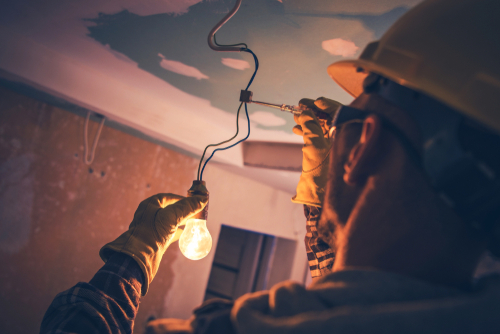Electricians install and maintain electrical power, communications, lighting, and control systems in homes, businesses, and factories. With these electrician duties some frequently occurring risks and illnesses are often found.

Electrician Duties
Electricians typically do the following:
- Read blueprints or technical diagrams
- Install and maintain wiring, control, and lighting systems
- Inspect electrical components, such as transformers and circuit breakers
- Identify electrical problems with a variety of testing devices
- Repair or replace wiring, equipment, or fixtures using hand tools and power tools
- Direct and train workers to install, maintain, or repair electrical wiring or equipment
Installing electrical systems in newly constructed buildings is less complicated than maintaining equipment in existing buildings. This is because electrical wiring is more easily accessible during construction. Also, maintaining equipment and systems involves identifying problems and repairing broken equipment that is sometimes difficult to reach. Maintenance work may include fixing or replacing parts, light fixtures, control systems, motors, and other types of electrical equipment. Electricians read blueprints, which are technical diagrams of electrical systems that show the location of circuits, outlets, and other equipment.
Many electricians work alone, but sometimes they collaborate with others. For example, experienced electricians may work with building engineers and architects to help design electrical systems for new construction. Some electricians may also consult with other construction specialists, such as elevator installers and heating and air conditioning workers, to help install or maintain electrical or power systems. At larger companies, electricians are more likely to work as part of a crew. They may direct helpers and apprentices to complete electrician jobs.
Work Schedules
Almost all electricians work full time, which may include evenings and weekends. However, work schedules may vary during times of inclement weather. During scheduled maintenance, or on construction sites, electricians can expect to work overtime.
Self-employed electricians often work in residential construction and may have the ability to set their own schedule.
Injuries and Illnesses
Electricians have a higher rate of injuries and illnesses than most other jobs. Although few accidents are potentially fatal, common injuries include electrical shocks, falls, burns, and other minor injuries.
The top 3 health problems electricians face and how you can prevent them:
1. Low Back Pain
The most common complaint electricians have is that their lower back aches. They have to lift heavy objects, squeeze into tight spaces, and spend huge amounts of time on their feet. Just one of these activities would put pressure on people’s backs, but electricians do all three, and more, on any given job. If they pull a muscle, they need to miss valuable work days.
2. Obesity
Electricians and other tradesman have a physically demanding schedule but their work is not proper exercise. Probably because of this intense workload, many electricians get too fatigued to maintain regular workouts. Lack of exercise can put electricians at risk of weight gain.
In addition to a less-active lifestyle, many electricians need to eat on the go. For example, a job is across town and it starts at 6 am. The electrician goes to a restaurant, grabs a coffee, and eats a bacon and egg sandwich. He works until 12 pm, then he goes to another job. On the way, he eats at a restaurant or fast food outlet. He goes to his next job. By the time is finished at 6 pm, he is so tired he eats whatever is in his refrigerator.
3. Heart Disease
The Center for Disease Control and Prevention (CDC) reports that older tradesmen are more likely to suffer from coronary heart disease or stroke. In particular, strokes are most common in male workers over the age of 55 who are current or former smokers. The CDC explains that work stress, noise and second hand smoke, and particle matter exposure negatively impact older electricians.
Conclusion
In the construction trade industry employers face a continuous shortage of skilled and trained employees, which means new jobs are more likely to be offered throughout the year. The need for master electricians has had an all-time high, and this need is expected to rise continuously due to the ongoing increase of new, green energies being used.

